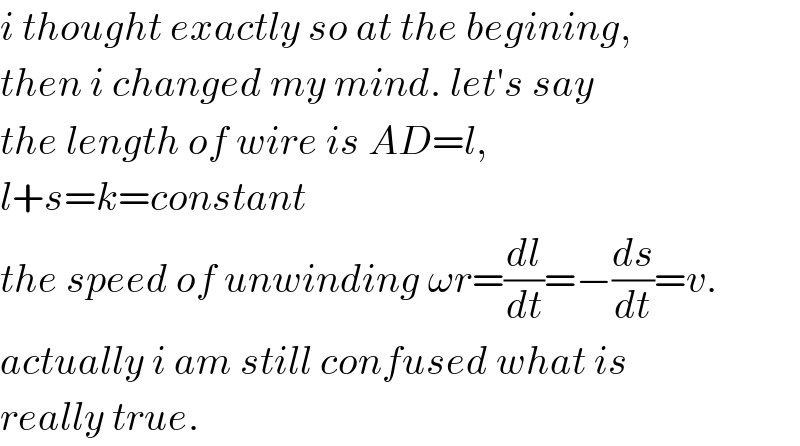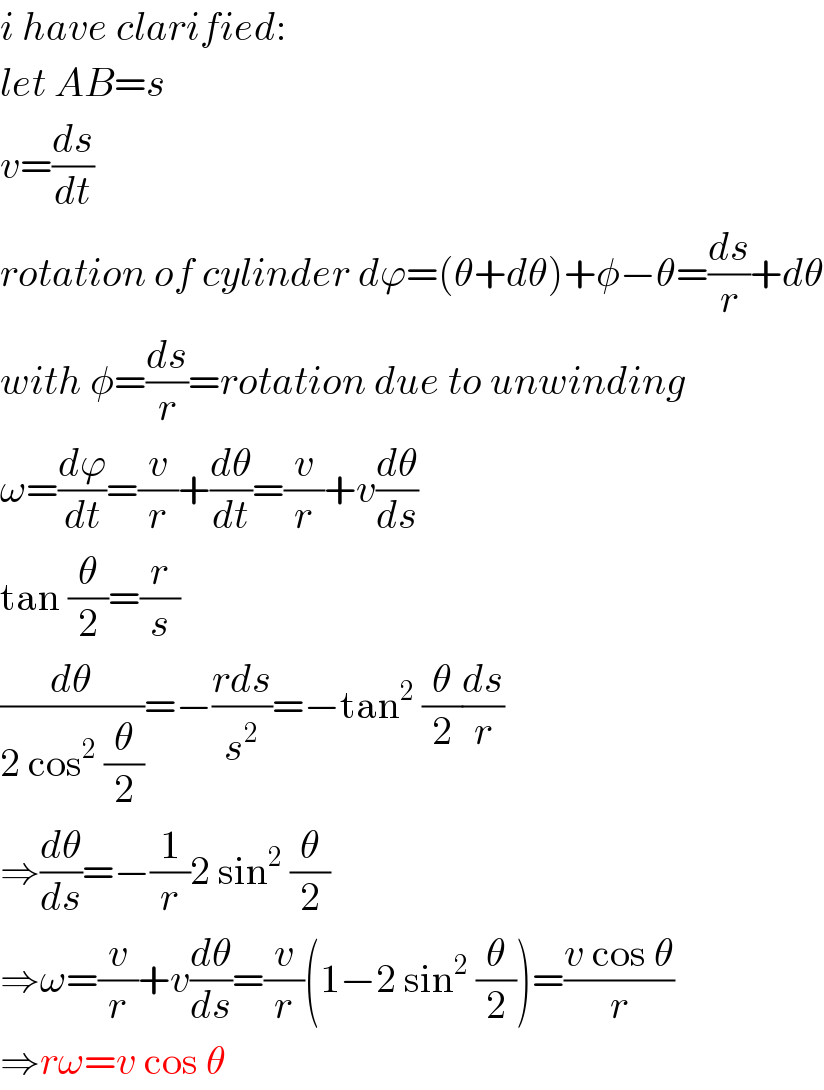
Question and Answers Forum
Question Number 71611 by ajfour last updated on 17/Oct/19

Commented by ajfour last updated on 17/Oct/19

Commented by ajfour last updated on 18/Oct/19

Answered by Tanmay chaudhury last updated on 18/Oct/19
![mg−Tcosα=ma Tsinα=N T.r=I((a/r))→T=((Ia)/r^2 ) mg−((Iacosα)/r^2 )=ma a(((Icosα)/r^2 )+m)=mg a=((mg)/(((Icosα)/r^2 )+m))→h=(1/2)at^2 →t=(√((2h)/a)) t=(√(((2h)/(mg))×(m+((Icosα)/r^2 )) )) t=(√(((2h)/(mg))×(m+((mr^2 cosα)/(2r^2 ))))) [I=((mr^2 )/2)] t=(√(((2h)/(mg))×m(1+((r^2 cosα)/(2r^2 ))))) t=(√(((2h)/g)×(1+((cosα)/2)))) pls check is it correct...](Q71675.png)
Commented by Tanmay chaudhury last updated on 18/Oct/19

Commented by ajfour last updated on 19/Oct/19

Answered by mr W last updated on 19/Oct/19

Commented by mr W last updated on 19/Oct/19
![i use β to replace α in the question AC=h+(r/(tan (β/2)))=s+(r/(tan (θ/2)))=k tan (θ/2)=(r/(k−s)) cos θ=((1−((r/(k−s)))^2 )/(1+((r/(k−s)))^2 ))=1−((2r^2 )/((k−s)^2 +r^2 )) mg−T cos θ=ma Tr=Iα I=((mr^2 )/2) α=(a/r) Tr=((mr^2 )/2)×(a/r) T=((ma)/2) mg−((ma cos θ)/2)=ma ⇒a=((2g)/(2+cos θ))=((2g)/(3−((2r^2 )/((k−s)^2 +r^2 ))))=((2g[(k−s)^2 +r^2 ])/(3(k−s)^2 +r^2 )) ⇒−v(dv/ds)=2g×(((k−s)^2 +r^2 )/(3(k−s)^2 +r^2 )) ⇒∫_0 ^v vdv=−2g∫_h ^s (((k−s)^2 +r^2 )/(3(k−s)^2 +r^2 ))ds ⇒(v^2 /2)=2g∫_h ^s (((k−s)^2 +r^2 )/(3(k−s)^2 +r^2 ))d(k−s) ⇒(v^2 /(4g))=∫_(k−h) ^(k−s) ((u^2 +r^2 )/(3u^2 +r^2 ))du ⇒(v^2 /(4g))=(1/3)[((2r)/(√3)) tan^(−1) (((√3)u)/r)+u]_(k−h) ^(k−s) ⇒(v^2 /(4g))=(1/3)[((2r)/(√3))(tan^(−1) ((√3)/(tan (θ/2)))−tan^(−1) ((√3)/(tan (β/2))))+(r/(tan (θ/2)))−(r/(tan (β/2)))] ⇒((3v^2 )/(4gr))=(2/(√3))(tan^(−1) ((√3)/(tan (θ/2)))−tan^(−1) ((√3)/(tan (β/2))))+(1/(tan (θ/2)))−(1/(tan (β/2))) ⇒v=((2(√(gr)))/(√3))(√((2/(√3))(tan^(−1) ((√3)/(tan (θ/2)))−tan^(−1) ((√3)/(tan (β/2))))+(1/(tan (θ/2)))−(1/(tan (β/2))))) ⇒(ds/dt)=((2(√(gr)))/(√3))(√((2/(√3))(tan^(−1) (((√3)(k−s))/r)−tan^(−1) ((√3)/(tan (β/2))))+((k−s)/r)−(1/(tan (β/2))))) ⇒((2(√(gr)))/(√3))∫_0 ^t dt=∫_h ^r (ds/(√((2/(√3))(tan^(−1) (((√3)(k−s))/r)−tan^(−1) ((√3)/(tan (β/2))))+((k−s)/r)−(1/(tan (β/2)))))) ⇒t=((√3)/(2(√(gr))))∫_h ^r (ds/(√((2/(√3))(tan^(−1) (((√3)(k−s))/r)−tan^(−1) ((√3)/(tan (β/2))))+((k−s)/r)−(1/(tan (β/2)))))) ......](Q71736.png)
Commented by ajfour last updated on 19/Oct/19

Commented by ajfour last updated on 19/Oct/19

Commented by mr W last updated on 19/Oct/19

Commented by ajfour last updated on 19/Oct/19

Commented by mr W last updated on 20/Oct/19

Commented by mr W last updated on 20/Oct/19

Commented by mr W last updated on 20/Oct/19
![new attempt: s_0 =(r/(tan (β/2))) s_1 =(r/(tan (β/2)))+h−r mg(s−s_0 )=(1/2)mv^2 +(1/2)Iω^2 g(s−s_0 )=(1/2)v^2 +(r^2 /4)ω^2 g(s−s_0 )=(1/4)v^2 (2+cos^2 θ) tan (θ/2)=(r/s) cos θ=((1−((r/s))^2 )/(1+((r/s))^2 ))=((s^2 −r^2 )/(s^2 +r^2 )) g(s−s_0 )=(1/4)v^2 [2+(((s^2 −r^2 )/(s^2 +r^2 )))^2 ] ⇒v=2(√((g(s−s_0 ))/(2+(((s^2 −r^2 )/(s^2 +r^2 )))^2 ))) ⇒(ds/dt)=2(√g)(√((s−s_0 )/(2+(((s^2 −r^2 )/(s^2 +r^2 )))^2 ))) ⇒t=(1/(2(√g)))∫_s_0 ^s_1 (√((2+(((s^2 −r^2 )/(s^2 +r^2 )))^2 )/(s−s_0 )))ds](Q71797.png)
Commented by ajfour last updated on 21/Oct/19

